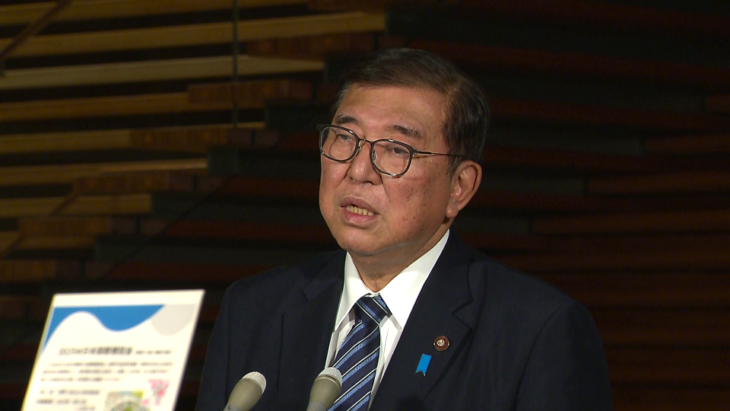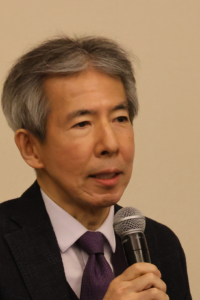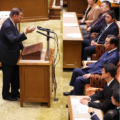Will Raising the Standards for the “1.03-million-yen Barrier” Save Young People? — Social media politics and livelihood security

“I have no idea. However, we hope that the discussion will continue despite the various perception gaps that may have surfaced.” (Prime Minister Ishiba, when asked whether there was a possibility of a breakdown in talks with the Democratic Party for the People on raising the 1.03-million-yen barrier standard, which were cut short within 10 minutes [December 17, 2024]).
Photo: Cabinet Public Affairs Office
With the rise of the Democratic Party for the People (DPP), the “tax barrier” suddenly emerged. How did the DPP’s electoral strategy come about, and who supported it? And to what extent will the expansion of tax exemptions actually reduce the burden, and on whose behalf? Let’s consider a system that can bring real voices into politics.
Two reasons for this focus
The issue of the “1.03-million-yen barrier[1]” suddenly became the focus of political discussion, and the media reported on it extensively day after day. This is none other than a measure to significantly raise the current income tax exemption limit from 1.03 million yen to 1.78 million yen, and is the flagship policy of the DPP, which made a breakthrough by quadrupling its number of seats in the general election on October 27, 2024. If the new limit is really 1.78 million yen, the tax cut will be 7 to 8 trillion yen, which is certainly not a small matter. However, even if it is raised to 1.78 million yen, it is estimated that the tax cut per month for those with an annual income of 3 million yen will be less than 10,000 yen. It seems a little strange that this has caused such a “fuss.” There are probably two reasons.
One is related to the meaning of the policy itself. This policy is not just a tax-cutting plan, but is meant to help young people and women while also confronting vested interests. The DPP has succeeded in giving this policy an aura of its own. At a debate between party leaders before the election announcement day, DPP leader Tamaki Yuichiro wrote “Don’t crush the young people” on a board distributed to emphasize that this policy is for the benefit of young people.
This appeal was successful, and according to an exit poll conducted by the Yomiuri shimbun newspaper and its Nippon Television Network affiliate on the day of the general election, the DPP was the most popular choice among people in their 20s, with 26% of the vote. Since the second Abe Shinzo administration, it was thought that the youth vote was flowing to the ruling Liberal Democratic Party (LDP), but this has now been snatched away.
Another reason is that negotiations over this policy have been pushed to the forefront for political reasons. The LDP, which became a minority party in the general election, desperately needs the DPP’s cooperation. Moreover, the younger generation is clearly behind this measure. Even if it is impossible to fully respond, raising the 1.03 million yen to some extent could hopefully shift public attention away from the issue of secret funds, which was the main cause of the general election defeat.
On the other hand, the DPP naturally wants to gain a track record of having the deciding vote and implementing policies that will lead to further expansion of support. The younger generation tends to see confrontational opposition parties (against the ruling party) as similar to the whiners (selfish people) they know, and the DPP also emphasizes negotiation with the ruling party, adopting the stance of “resolution over confrontation.” The second of these political circumstances is easy to understand. However, it seems necessary to delve a little deeper into the first point — why this policy has attracted expectations and support.
The atmosphere is not an illusion
It is important to read the mood of the voters who pushed this policy forward, hoping to break down the “1.03-million-yen barrier.”
The most fundamental reality that has fostered this atmosphere is the rising prices and hardships that many people, including young people, are facing and groaning under. This reality is compounded by the feeling that the existing social security, tax and employment systems are not working and are in fact crushing young people, and from this point on, an atmosphere mixed with rather simplistic interpretations spreads.
In other words, social security is now limited to benefits for the elderly, and the working generation is forced to bear the burden. Taxes are taken and never returned. Various employment practices and regulations only protect the middle-aged and elderly… and so on, creating an atmosphere of dissatisfaction that permeates society.
This atmosphere is no illusion. At its root is an undeniable reality. I use the word atmosphere here not to criticize this situation as “populism” or “mob rule” or anything like that. It is true that in the atmosphere created by social media, problems with systems and policies are oversimplified and one-sided. But there is a lot of truth in this simplified and one-sided atmosphere.
Just think about it. People who used to vote according to the instructions of influential people in their communities or the organizations they belong to, or young people who never paid any attention to elections, are starting to raise their voices on extremely complex issues such as social security systems and employment practices. In any case, the starting point for politics is to read these signals correctly.
The DPP, or rather its leader, Tamaki, sensed this and made a strong case that the measures regarding the “1.03-million-yen barrier” were the optimal solution. This skill has tended to be lacking in opposition parties up until now, and I think it should be evaluated frankly, not sarcastically. It sounds hollow to describe this situation as “young people being manipulated.”
On the other hand, this staged performance comes at a cost. Will the actual effect of breaking down the “1.03-million-yen barrier” be commensurate with the expectations that have been raised (or raised by the media)? First of all, is this policy an income guarantee for those in financial difficulty, employment support, support for young people, support for part-time housewives, or a measure to raise the bottom line of the economy? The DPP has claimed that it is all of these things, and it could be said that it has taken advantage of its iridescent shine. However, on the other hand, the effects of all of these measures may be insufficient, which could lead to disappointment among voters.
I stated that it is an important role of politics to propose measures while reading the mood and arousing people’s interest. However, the real power of politics lies beyond that, and it is a question of how to confront and solve the real difficulties that lie at the root of the situation. In this case, it will be necessary to eliminate the divisions and rumors that prevent the solution of the problem. If there are any shortcomings in the proposed measures, it will be necessary to correct them or supplement them with other measures.
Basic income plan withdrawn
First, let’s look at this policy as a response to financial difficulties. Until now, the pillar of the DPP’s social security policy, especially its income security policy, has been the “Japanese-style Basic Income” system of refundable tax credit. Even now, the DPP’s policy index lists a “Japanese-style Basic Income” along with income tax cuts as a measure for an “economy in which wages and pensions rise.” However, the “Democratic Party for the People 2024 Priority Policies,” announced just before the general election, does not include the phrase “Japanese-style Basic Income” and instead lists at the top a plan to raise the “1.03-million-yen barrier.”
Refundable tax credit is a system in which, for example, 100,000 yen is deducted from the tax amount itself, and the amount that cannot be deducted is paid in cash to low-income people whose tax amount is less than 100,000 yen. This is a system that places more emphasis on supporting low-income earners than basic income in the narrow sense.
In contrast, the Daiwa Institute of Research estimates the tax reduction effect of raising the “1.03-million-yen barrier” for single individuals to be about 80,000 yen for an annual income of 2 million yen and about 220,000 yen for an annual income of 8 million yen. In other words, the effectiveness of support for low-income earners is limited.
I myself believe that the axis of future income security will be tax credits with benefits combined with diverse working styles. Therefore, I wondered why this had disappeared from the “Priority Policies.” However, afterwards, I heard DPP leader Tamaki say that he had focused on the idea of raising the tax to 1.03 million yen because he felt strong support for this during the election campaign preparations, and in a way, it made sense to me.
Refundable tax credits require infrastructure development such as income capture, and is one of the tax reforms aimed at supporting low-income earners, but it is not easy to explain how it works. At the very least, it’s hard to say that it’s a catchy policy that will gain widespread support on social media. On the other hand, the “1.03-million-yen barrier” leaves a strong impression on many people, both because of the phenomenon of take-home pay decreasing even as income increases due to higher dependent deductions and social insurance contributions, and because of the name itself. In particular, when people hear the phrase “increase your take-home pay,” many working-age people will have a realistic picture of the taxes and insurance premiums listed in the deductions section of their paychecks. In addition, a simplistic argument may come to mind: “While the working generation bears a heavy tax burden, the older generation enjoys the benefits.” In this climate, breaking the “1.03-million-yen barrier” is a policy that is much more likely to gain support than refundable tax credits.
However, the question of the measure’s ability to address hardship remains. In particular, on the issue of financing the policy, the DPP points out that too much consumption tax has been collected due to rising prices, which has led to an increase in tax revenue for the government, and explains that raising the “1.03-million-yen barrier” is a way to return the excess tax to taxpayers. If this is the case, it is clearly low-income earners who are being overcharged with the consumption tax, and it would be necessary to focus on “returning” it to this group.
The ambiguous nature of breaking down the “1.03-million-yen barrier”
Even when considering generations and genders apart from income classes, it remains ambiguous as to who and how breaking down the “1.03-million-yen barrier” is intended to support. Originally, this term was understood not as an “income tax barrier” but as a “work barrier” in which housewives, especially those working part-time, adjust their working hours to avoid being taxed and having their take-home pay reduced. However, the 1.5-million-yen barrier, which means that the full amount of the spousal special deduction cannot be received, is now the axis of adjustment for income tax. Furthermore, there are other important barriers besides income tax, such as the 1.06-million-yen barrier beyond the 1.03-million-yen barrier, which requires people to join social insurance, and the 1.3-million-yen barrier, which means people lose their eligibility for category 3 insured persons[2] under the National Pension and are required to pay insurance premiums.
If part-time homemakers are not the main target, will it be students who are dependent on their parents who will benefit from the removal of the barrier? If students are concerned about the increased burden on their parents and are limiting their part-time work hours, we need to consider why they are increasing their part-time work hours between classes. If the purpose is to shoulder the burden of tuition fees, the first thing needed to support such students would be to expand the grant-type scholarships that are also listed in the DPP policy index.
Furthermore, even when part-time housewives and students work to increase their take-home pay, many are forced to work in non-regular jobs with low wages and few opportunities for career development. Measures to remove barriers to employment must be integrated with measures to improve working conditions.
Cutting through the atmosphere to break the status quo
Many commentators have said that the DPP, which proposed raising the “1.03-million-yen barrier” and negotiated with the ruling party, is being populist or trying to curry favor with the ruling party, but I don’t necessarily think that’s the case. It is the basic role of the opposition party to read the social atmosphere correctly, come up with appealing policies, and bring the ruling party to the negotiating table. I also don’t think that all opposition party proposals must have a financial outlook.
However, the policy of raising the “1.03-million-yen barrier” itself has problems, as we have seen so far. In particular, it is questionable to what extent it will have a real effect on supporting young people. In order to read the situation and address the underlying reality at the same time, shouldn’t we take advantage of the interest this measure has attracted to propose a more comprehensive policy package?
By the way, it is the Ministry of Finance that is taking advantage of the atmosphere created by the difficulties of young people and the rumor that “social security only benefits the older generation” and using it to create convenient policies. The idea of a “Social Security System Oriented to All Generations,” which was originally intended to strengthen support for young people, has been completely reworked to provide a justification for promoting the reduction of spending on pensions, nursing care, medical care and other expenditures for the elderly generation. The logic is that “all generations” includes not only the working generation, but also future generations, and if an all-generation approach means not creating debt, then this will also lead to spending cuts.
Home care fees have also been reduced, but as a result, if employment in the nursing and medical fields deteriorates, the younger generation will also be hit hard. Regardless of whether the Ministry of Finance is a “boss character[3],” there is no room for complacency. If they really want to confront the Ministry of Finance, they must not only keep repeating the argument for tax cuts, which could be used as a justification for spending cuts, but also come up with benefits that will reach and energize young people. There is opposition to being taxed, but little criticism of the way benefits are delivered. For example, only a small portion of the increased burden from the comprehensive reform of the social security and taxation systems has been allocated to childcare assistance as promised, with the bulk going to debt repayment and other purposes, but this is rarely pointed out. As for the DPP, its policy index contains many proposals for new benefits, from education and childcare support to employment support. I hope to see a policy that cuts into the social atmosphere.
Translated from “‘103 man-en no kabe’ Hikiage wa Wakamono wo Sukuka: SNS-seiji to Seikatsuhosho (“Will Raising the Standards for the ‘1.03-million-yen Barrier’ Save Young People? Social media politics and livelihood security”), Sekai, January 2025, pp. 152–156. (Courtesy of Iwanami Shoten, Publishers) [February 2025]
[1] The “1.03-million-yen barrier” means that if a person earns less than 1,030,000 yen from part-time work and has no other income, he or she is not subject to income tax and his or her spouse is entitled to a spousal deduction if certain requirements are met.
[2] Spouses who are supported by a Category 2 insured person* and who are aged 20 to 60 years old and have an annual income of less than 1.3 million yen in principle (even if their annual income is less than 1.3 million yen, if they meet the requirements for joining the Employees’ Pension Insurance, they will be enrolled in the Employees’ Pension Insurance and Health Insurance, and will not be considered Category 3 insured persons).
*Company employees and public servants who are enrolled in the Employees’ Pension Insurance or a mutual aid association. However, this does not include those who are 65 years old or older and are entitled to receive the basic old-age pension, etc.
[3] A “boss character” refers to a powerful enemy that appears at key points in a game’s stages or storyline. The term is also used metaphorically to describe a symbolic figure who stands in the way during challenging situations or critical moments.
Keywords
- 1.03-million-yen barrier
- 1.78 million yen
- basic income
- income tax barrier
- work barrier
- income tax exemption
- tax credit
- taxes
- income security
- social security
- benefits
- Democratic Party for the People
- DPP
- Tamaki Yuichiro
- social media
- young people
- low-income earners
- rising prices
- hardships
 MIYAMOTO Taro, Ph.D.
MIYAMOTO Taro, Ph.D.


